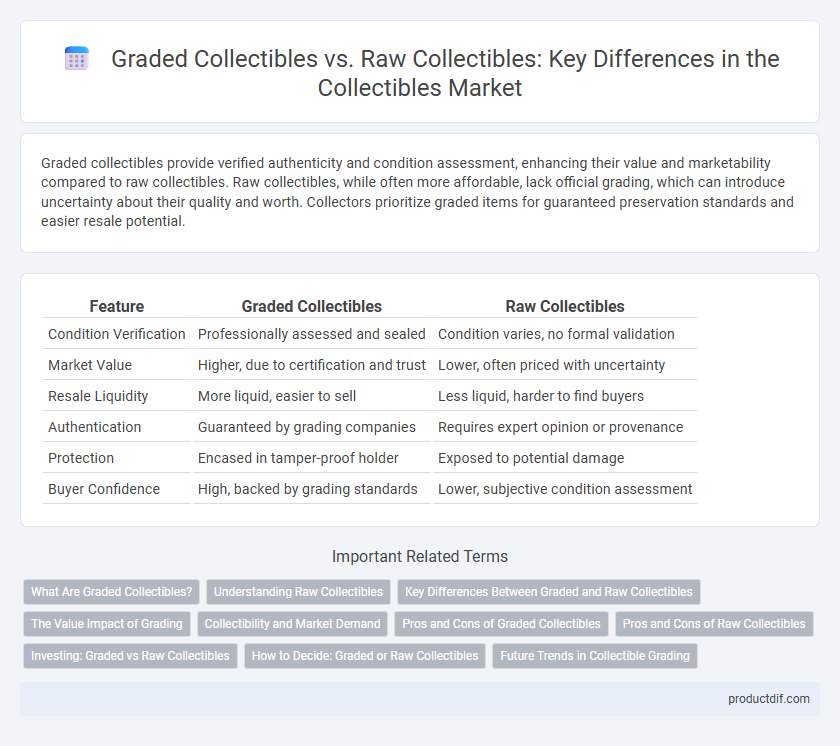Graded collectibles provide verified authenticity and condition assessment, enhancing their value and marketability compared to raw collectibles. Raw collectibles, while often more affordable, lack official grading, which can introduce uncertainty about their quality and worth. Collectors prioritize graded items for guaranteed preservation standards and easier resale potential.
Table of Comparison
| Feature | Graded Collectibles | Raw Collectibles |
|---|---|---|
| Condition Verification | Professionally assessed and sealed | Condition varies, no formal validation |
| Market Value | Higher, due to certification and trust | Lower, often priced with uncertainty |
| Resale Liquidity | More liquid, easier to sell | Less liquid, harder to find buyers |
| Authentication | Guaranteed by grading companies | Requires expert opinion or provenance |
| Protection | Encased in tamper-proof holder | Exposed to potential damage |
| Buyer Confidence | High, backed by grading standards | Lower, subjective condition assessment |
What Are Graded Collectibles?
Graded collectibles are items that have been professionally evaluated and assigned a condition score by a recognized grading service, such as PSA, Beckett, or CGC. This certification provides an objective assessment of authenticity, quality, and condition, often increasing the collectible's market value and buyer confidence. Graded collectibles come encapsulated in tamper-evident holders, preserving their condition and provenance for collectors and investors.
Understanding Raw Collectibles
Raw collectibles refer to items that have not undergone professional grading or authentication processes, making their condition and authenticity less certain to buyers. These ungraded items often come with lower market prices but carry higher risks regarding durability, value, and potential for counterfeit issues. Collectors seeking raw collectibles must rely on personal knowledge and thorough inspection to assess their genuine worth and condition.
Key Differences Between Graded and Raw Collectibles
Graded collectibles undergo professional evaluation and encapsulation, providing an authenticated condition grade that significantly impacts market value and buyer confidence. Raw collectibles lack this formal assessment, making their condition and authenticity reliant on personal inspection, which can lead to value uncertainty. The primary distinction lies in certified quality assurance and enhanced liquidity for graded items, while raw collectibles offer more flexibility but with increased risk.
The Value Impact of Grading
Graded collectibles often command higher market values due to the certification of authenticity and condition provided by reputable grading services, which reduces buyer uncertainty and enhances trust. Raw collectibles lack this third-party verification, resulting in greater price volatility and typically lower demand. The grading process establishes a standardized quality benchmark, making graded items more attractive to serious collectors and investors.
Collectibility and Market Demand
Graded collectibles consistently command higher market demand due to certified authenticity, verified condition, and enhanced trust among collectors. Raw collectibles, while often more affordable, carry greater risk regarding condition discrepancies and authenticity doubts, impacting their overall collectibility. Collector preference strongly favors graded items for investment stability and resale value maximization.
Pros and Cons of Graded Collectibles
Graded collectibles offer verified authenticity, professional condition assessment, and enhanced market value, making them highly desirable for serious collectors and investors. However, the grading process can be costly and time-consuming, potentially reducing immediate liquidity, while some collectors may prefer raw items for their untouched and original state. The grading companies' standards and subjective evaluations may also lead to disputes over assigned grades and affect long-term resale prices.
Pros and Cons of Raw Collectibles
Raw collectibles offer the advantage of lower purchase prices compared to graded counterparts, allowing collectors to acquire rare items affordably. However, raw items lack professional authentication, which can lead to difficulties in verifying authenticity and condition, potentially affecting resale value. The absence of standardized grading means buyers must rely heavily on personal expertise to assess quality and avoid counterfeit or damaged products.
Investing: Graded vs Raw Collectibles
Graded collectibles offer verified authenticity and condition, which significantly enhances their market value and liquidity compared to raw collectibles. Investors benefit from standardized grading scales provided by reputable companies like PSA or Beckett, reducing the risk of counterfeit or misleading condition claims. Raw collectibles, while often cheaper initially, carry greater uncertainty and can require expert knowledge to assess true worth, making graded items a safer investment choice.
How to Decide: Graded or Raw Collectibles
Choosing between graded and raw collectibles depends on factors like authenticity, condition assurance, and market value transparency. Graded collectibles offer professional evaluation and protection, enhancing buyer confidence and resale potential. Raw collectibles appeal to those preferring lower costs and personal assessment flexibility, but they carry higher risks of undisclosed flaws and authenticity disputes.
Future Trends in Collectible Grading
Graded collectibles offer verified authentication and condition ratings, increasing market confidence and resale value, while raw collectibles lack this standardized assessment, often leading to price uncertainty. Future trends in collectible grading include the integration of blockchain technology for transparent provenance tracking and AI-powered condition analysis to enhance grading accuracy. As the industry evolves, these innovations will likely drive greater demand for graded collectibles, shaping the collectible market's growth and reliability.
Graded Collectibles vs Raw Collectibles Infographic

 productdif.com
productdif.com